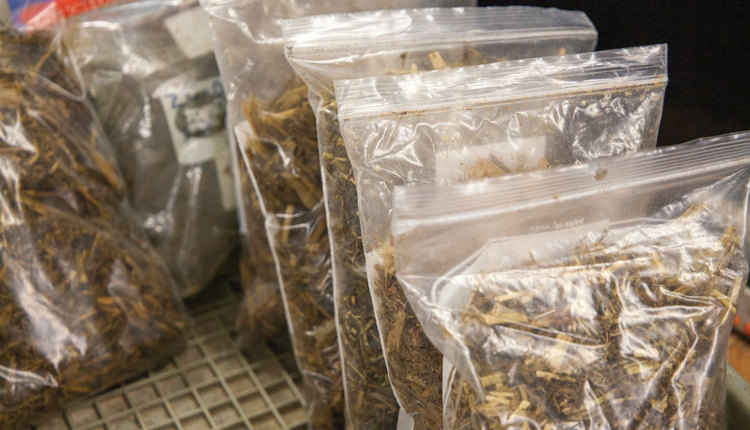Forage and ration sampling revisited |
| By John Goeser |
|
|
The author is the director of nutrition research and innovation with Rock River Lab Inc., and adjunct assistant professor, University of Wisconsin-Madison’s Dairy Science Department. Most of the variation in forage testing results comes from sampling rather than the lab.
Think about picking out a person or two in the stands at a baseball game and expecting them to be representative of the entire crowd that day. This probably seems a bit outlandish, and it should. We readily recognize that one or two people, either for good or for bad, do not represent the crowd at large in appearance, beliefs, or opinions. However, I’ve used this metaphor in the past to explain the challenges we face in forage and ration sampling. Dairy and beef farms harvest, store, and feed forage and rations by the tens of thousands of pounds. Collecting a 1 pound composite forage sample and expecting this to appropriately represent 20,000 pounds of feed is challenging to say the least. This isn’t to suggest that feed sampling and testing is useless, but we need to be cognizant of what a single sample represents. Then we can proceed accordingly with an improved statistical understanding and approach to nutritional or quality data and expectations. Thanks to research from Bill Weiss and Norm St-Pierre at The Ohio State University, we have a concrete understanding of the factors that contribute variance to feed sampling. Their recommendations include additional sample repetitions when getting into new feeds, yet few practice their advice. Single samples don’t get the job done and need to be interpreted with caution. Building upon these findings, a team of researchers I helped assemble at the University of Wisconsin and Rock River Laboratory found that a majority of sampling variance is tied to the farm. In fact, the sampling variance is 10 to over 60 times greater at the farm relative to the lab. What’s the practical take home point? The feed testing laboratory technician contributes relatively little variation to results and far more variation comes from sampling at the farm. Like sighting in a rifle Back to the point raised above: This doesn’t mean that sampling is useless; however, we need basic statistical training to improve the way we make decisions or spend money tied to feed or ration testing. Last year at the High Plains Dairy Conference in Texas, I brought a scope and rifle metaphor into an invited seminar I gave discussing hidden nutrition and economic opportunities. I contend that determining your feed moisture or nutritional value is like sighting in a rifle with a new scope. Experience shows that mounting the scope on the rifle, taking a single shot, and then making adjustments to zero in the scope will lead to erroneous adjustments. Now think of feed sampling like single rifle shots with a newly mounted scope. Single samples — even composites — are just one estimate of what the feed’s true value is in terms of moisture or quality. As described above, sampling variance at the farm and laboratory contribute a bit of variation to single samples. There is no way to eliminate these variance factors just like there is no way to shoot a perfect single shot and then adjust your scope. We readily recognize that three to five shots are needed to sort out a pattern, and only then can we proceed to adjust the scope to zero. Feed testing is no different. Multiple samples or observations need to be accounted for to represent the population of feed analysis results more accurately. Nutritionists often integrate several sample results when making decisions; however, these results sometimes span weeks to months. In adopting the approach here, the three to five observations should be made over a reasonable period of time relative to the decisions at hand. For some, this time period is week to week, but for others, it’s monthly or quarterly. Stopping short of a course in statistics, understand that your feed quality can be thought of as a population, just like the population of people at a stadium described above. The population of feed quality may be defined by a truckload, a lot of hay bales, or 10,000 tons of feed under plastic. The feed quality population may also be defined by a week’s worth of feed or a ration fed to a pen or herd. This is a different concept for us to think about, but the population needs to be defined. Then, with the population in mind, we can recommend an appropriate sampling scheme to accurately characterize the population. Take three to five shots The recommended sampling approach to define the feed moisture or quality “population” is no different than sighting in your new scope. I recommend three to five observations to accurately get a handle on your feed’s value. This may mean several samples from a lot of hay, or several samples collected over a meaningful period of time while feeding out a forage (for example, two to four weeks). Take this topic up with your nutritionist or hay broker to chart out a strategy. Forward thinking dairy and beef feeders are locking into this approach, recognizing sizable swings in moisture or nutritional value that have been previously covered up due to insufficient nutrition data. In closing, build upon your current sampling program to include more observations over time prior to making high-value decisions. Interpret single sample results with caution, recognizing one analysis is just like sighting in a new scope with a single shot. This article appeared in the August/September 2023 issue of Hay & Forage Grower on page 19. Not a subscriber? Click to get the print magazine. |
